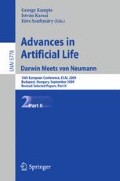Abstract
This paper reports on foundational considerations for experiments into the acquisition of human-like use and understanding of negation in linguistic utterances via a developmental robotics approach. For this purpose different taxonomies of negation in early child language are analysed in order to show the large variety of communicative functions that these different types of negation have. Requirements for robotic systems that aim at acquiring these utterances in a linguistically unconstrained human-robot dialog are derived from this analysis.
Access this chapter
Tax calculation will be finalised at checkout
Purchases are for personal use only
Preview
Unable to display preview. Download preview PDF.
References
Austin, J.L.: How to Do Things with Words. Harvard University Press, Cambridge (1975)
Bloom, L.: Language Development: Form and Function in Emerging Grammars. M.I.T. Press, Cambridge (1970)
Choi, S.: The semantic development of negation: a cross-linguistic longitudinal study. Journal of Child Language 15(3), 517–531 (1988)
Clark, E.V.: First Language Acquisition. Cambridge University Press, Cambridge (2009)
Dominey, P.F., Metta, G., Nori, F., Natale, L.: Anticipation and initiative in human-humanoid interaction. In: 8th IEEE-RAS Intl. Conf. Humanoid Robots, pp. 693–699 (2008)
Dominey, P.F., Boucher, J.D.: Learning to talk about events from narrated video in a construction grammar framework. Artificial Intelligence 167, 31–61 (2005)
Guillaume, P.: Les débuts de la phrase dans le langage de l’enfant. Journal de Psychologie Normale et Pathologique 24, 1–25 (1927)
Harnad, S.: The symbol grounding problem. Physica D 42, 335–346 (1990)
Maynard Smith, J., Szathmáry, E.: The Major Transitions in Evolution. Oxford University Press, Oxford (2002)
Nagai, Y., Rohlfing, K.J.: Computational analysis of motionese toward scaffolding robot action learning. IEEE Trans. Autonomous Mental Development 1(1) (2009)
Nehaniv, C.L., Dautenhahn, K., Loomes, M.J.: Constructive Biology and Approaches to Temporal Grounding in Post-Reactive Robotics. In: McKee, G.T., Schenker, P. (eds.) Sensor Fusion and Decentralized Control in Robotics Systems II. Proc. of SPIE, vol. 3839, pp. 156–167 (1999)
Owens, R.E.: Language Development: An Introduction. Pearson Education, London (2007)
Pea, R.: The Development Of Negation In Early Child Language. In: Olson, D.R. (ed.) The Social Foundations of Language & Thought: Essays in Honor of Jerome S. Bruner, pp. 156–186. W.W. Norton, New York (1980)
Roy, D.: Semiotic schemas: A framework for grounding language in action and perception. Artificial Intelligence 167(1-2), 170–205 (2005)
Roy, D., Reiter, E.: Connecting language to the world. Artificial Intelligence 167, 1–12 (2005)
Saunders, J., Lyon, C., Förster, F., Nehaniv, C.L., Dautenhahn, K.: A Constructivist Approach to Robot Language Learning via Simulated Babbling and Holophrase Extraction. In: Proc. 2nd Intl. IEEE Symposium on Artificial Life, pp. 13–20 (2009)
Searle, J.R.: Speech Acts: An Essay in the Philosophy of Language. Cambridge University Press, Cambridge (1969)
Steels, L.: The origins of syntax in visually grounded robotic agents. Artificial Intelligence 103(1-2), 133–156 (1998)
Steels, L.: Evolving grounded communication for robots. Trends in Cognitive Science 7(7), 308–312 (2003)
Tomasello, M.: Constructing a Language. Harvard University Press, Cambridge (2003)
Author information
Authors and Affiliations
Editor information
Editors and Affiliations
Rights and permissions
Copyright information
© 2011 Springer-Verlag Berlin Heidelberg
About this paper
Cite this paper
Förster, F., Nehaniv, C.L., Saunders, J. (2011). Robots That Say ‘No’. In: Kampis, G., Karsai, I., Szathmáry, E. (eds) Advances in Artificial Life. Darwin Meets von Neumann. ECAL 2009. Lecture Notes in Computer Science(), vol 5778. Springer, Berlin, Heidelberg. https://doi.org/10.1007/978-3-642-21314-4_20
Download citation
DOI: https://doi.org/10.1007/978-3-642-21314-4_20
Publisher Name: Springer, Berlin, Heidelberg
Print ISBN: 978-3-642-21313-7
Online ISBN: 978-3-642-21314-4
eBook Packages: Computer ScienceComputer Science (R0)

